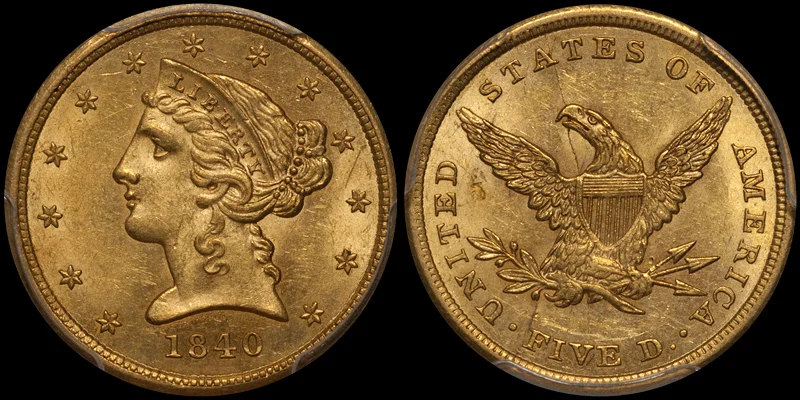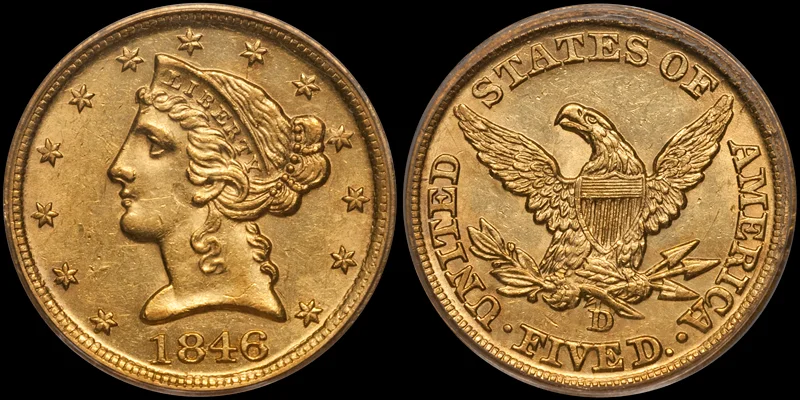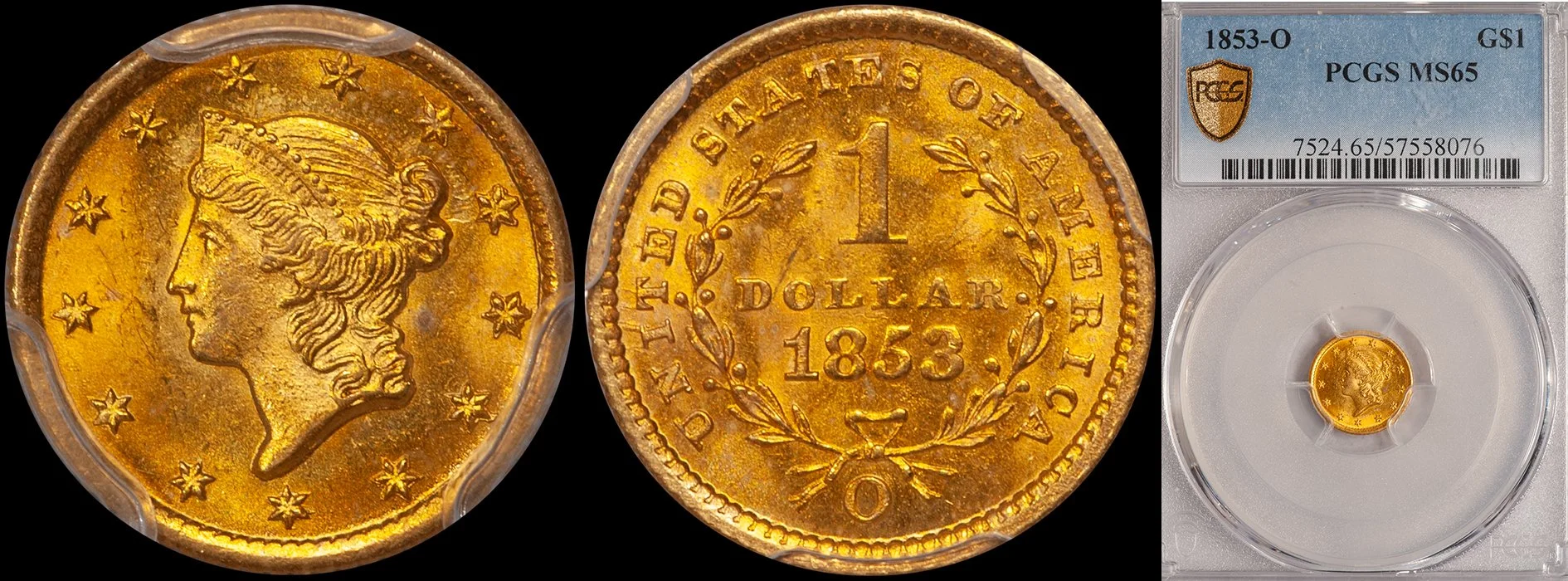Six Liberty Head Gold Issues Which Have Been "Ruined" by the Grading Services
/The powers that be at PCGS and NGC have never sat down and said “let’s deliberately ruin such and such issue by misattributing them or miscalculating them.” Unfortunately, this is exactly what they have done on a number of important U.S. gold coins. I have selected six. There are more, but these examples are egregious enough to merit discussion.
1. 1840 and 1840-O Half Eagles (PCGS only)
I have lobbied for the inclusion of the 1840 and 1840-O Broad Mill half eagles before. They are important naked eye varieties and there is precedence as NGC has rightfully recognized the two varieties (Narrow Mill and Broad Mill) with some degree of consistency for years.
1840 $5.00 PCGS MS62+ CAC
What I don’t like about PCGS’ ignoring of the 1840 and 1840-O Broad Mill is that they are unfairly penalizing both unknowledgeable and knowledgeable submitters. If you don’t know that these varieties exist and you sell a rare 1840-O Broad Mill as a common Narrow Mill, the grading service isn’t doing its job of representing the consumer. If you are smart enough to know your coin is a Broad Mill but the variety isn’t recognized by PCGS on the holder, you have to “convince” the buyer that you are savvier than PCGS.
Finally, as a leading specialist in New Orleans gold, I wish that PCGS would properly designate all the 1840-O half eagles they have graded to date. This way we can once and for all get a handle on how rare the 1840-O Broad Mill is (I contend it’s by far the rarest half eagle from this mint). And I’d like to see it claim its proper place in the “regular” set of New Orleans half eagles.
2. 1846-D and 1846-D/D Half Eagles (Mostly NGC)
The 1846-D Normal Mintmark and 1846-D over D mintmark are pretty straightforward naked-eye varieties which have both been recognized by the services since they opened. Unfortunately, many of the 1846-D Normal Mintmark half eagles that I see in NGC holders (and a few in PCGS holders as well) are misattributed with D/D coins in Normal D holders.
an example of an 1846-D/D $5.00 in MS61
As a result, the population figures for the scarcer 1846-D are skewed and I believe that this has hurt the price of this variety. I believe that the 1846-D is decidedly scarcer than the 1846-D/D, especially in higher grades, but you can’t properly determine this based on NGC (and to some extent PCGS) population figures.
There is an easy solution to this. NGC could offer to properly re-designate any incorrectly designated 1846-D or 1846-D/D half eagle for free and then make these changes on their Census Report. It won’t magically clear up all the mistakes overnight but it will help
3. 1854-C Half Eagle
This issue has been messed up for years and by both services. As a result, the true rarity of the 1854-C half eagle is unrecognized by most collectors and dealers.
1854-C half eagles are found with two die varieties. The first (Winter 1) has the mintmark far to the left and the C is strong to the naked eye. It is scarcer than the second variety and it is very rare in AU55 and higher grades. The second (Winter 2) has the mintmark placed further to the right and the C is weak; sometimes being nearly invisible. This variety is more common and it is far less desirable.
1854-C $5.00 PCGS AU58
The problem is that both services, while they recognize “regular” 1854-C half eagles and Weak C varieties, are very inconsistent with their usage. I have seen 1854-C half eagles in both PCGS and NGC holders with faint, nearly invisible mintmarks not designated as “Weak C” and vice-versa.
The solution is easy. Both services should issue a “recall” on all 1854-C half eagles and properly designate them. The Winter-1 coins should be designated on the holder as “Strong C” while the Winter-2 coins should be designated as “Weak C.” The new results can be recorded as the populations changed accordingly.
4. 1846-O Eagle
Sigh…the poor 1846-O eagle and its counterpart the fictitious “1846/5-O.” When I wrote the first edition of my book on New Orleans gold back in the 1990’s, I clearly stated that ALL 1846-O eagles are Normal Dates. There are die varieties of 1846-O eagle with an artifact in the loop of the 6, but this same die marker is found on certain 1846-O half dollars and it is in the date punch.
"1846/5-O" $10.00 PCGS EF45 CAC
For many years, both PCGS and NGC ignored my findings and listed two separate varieties of 1846-O eagle: the 1846-O (“Normal Date”) and the 1846/5-O (“overdate”). A few years ago, PCGS realized its error and started calling the so-called overdate the “1846/’5’-O. Then, they dropped the overdate designation entirely and began recognizing just the one variety. I’m not quite certain of the time line which NGC used but their current policy appears to be the same.
This is great but it created a large pool of coins designated as 1846/5-O or 1846/’5’-O which are not what they say they are and sell for a premium as a result of this misdesignation. I suggest a recall of all 1846-O eagles by both services with the result of removing the 1846/5-O designation once and for all.
5. 1853/2 Double Eagle
The current thinking on this overdate is that it is actually a recut date (1853/3) and not a bona-fide overdate (1853/2). A few years ago—without an apparent notice—PCGS and NGC both began designating this variety as 1853/’2’ which, in my opinion, is a pretty lame way of saying “we don’t recognize this variety as an overdate like we used to but we aren’t going to undesignated it and void our guarantee on the other 200+ we’ve already attributed as an overdate.”
1853/2 $20.00 PCGS AU50 CAC
So…if you bought an 1853/2 $20 for your collection a decade ago, it is designated by both services as an 1853/2. If you bought one in February 2016, it is designated as 1853/’2.’ Same coin, vastly different interpretation and a very important difference, if I may say so.
At the very least, NGC and PCGS need to recall the older 1853/2 double eagles and “modernize” the designation.
6. 1854-S Double Eagle
I can’t think of a single U.S. gold coin which is more messed-up by grading service inconsistencies than the 1854-S double eagle.
There are an estimated 400-500 examples known of this date. The majority of these have finely granular surfaces from exposure to seawater and are from a hoard found in the 1970’s. The problem is that these are not designated as “seawater” coins by NGC or PCGS and this, in turn, fails to recognize the difference in appearance between these coins and those with “natural” surfaces. Furthermore, many of the PCGS and NGC graded 1854-S double eagles have such a strong seawater appearance that I consider them to have environmental damage and, therefore, not able to “straight grade.”
1854-S $20.00 PCGS AU58
If I were to take, say, an 1851-C half eagle with blatantly seawater surfaces and send it into PCGS, there is a very good chance that it would be returned as a “no grade.” If this is so, why are the seawater 1854-S double eagles not only straight graded but not penalized by their appearance? I contend that if 90% of the same seawater 1854-S double eagles already in holders were submitted today and graded by 2016 standards, they wouldn’t straight grade.
This has created an unusual market condition for 1854-S double eagles. The much rarer non-shipwreck coins are now selling for a premium over their seawater counterparts; unlike all other shipwreck Type One double eagles which bring a premium over their non-shipwreck counterparts.
My solution to this problem is for the services to designate non-seawater 1854-S as “non-shipwreck” coins on the holder and let the market reward these coins by virtue of their greater rarity.
Are there other 18th, 19th and 20th century gold issues which you think have been “messed up” by the grading services? Please share your thoughts in the comments section below.



















